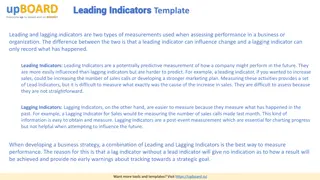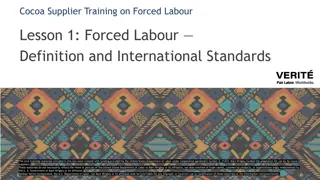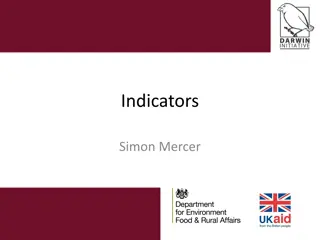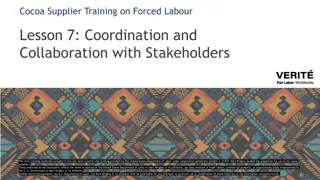Practical Guidance on Localizing Indicators in Cocoa Supplier Training
This training session focuses on providing practical guidance for localizing indicators in the context of cocoa supply chains to address forced labor issues. Participants will learn how to adapt indicators to specific local contexts, develop relevant indicator lists, and create monitoring questions tied to each key indicator identified. The session covers both top-down and bottom-up approaches for localizing indicators effectively.
Download Presentation

Please find below an Image/Link to download the presentation.
The content on the website is provided AS IS for your information and personal use only. It may not be sold, licensed, or shared on other websites without obtaining consent from the author. Download presentation by click this link. If you encounter any issues during the download, it is possible that the publisher has removed the file from their server.
E N D
Presentation Transcript
Cocoa Supplier Training on Forced Labour Lesson 6: Practical Guidance for Using the Indicator Approach The core trainings materials included in this site were created with funding provided by the United States Department of Labor under cooperative agreement number IL 31474. Mars Wrigley funded the adaptation for use by its cocoa suppliers. These materials do not necessarily reflect the views or policies of the United States Department of Labor or Mars Wrigley or its affiliates, nor does mention of trade names, commercial products, or organizations imply endorsement by the U. S. Government or Mars Wrigley or its affiliates. Neither Verit Incorporated, the U.S. Department of Labor, nor Mars Wrigley or its affiliates shall be held liable for any improper or incorrect use or modification of these materials or the information contained herein.
Objective To help participants learn: how indicators can be localized to specific supply chain contexts, and how a list of relevant indicators can be developed and how to create research or monitoring questions tied to each key indicator identified and understand worker responses 2 2 Cocoa Supplier Training on Forced Labour
Step 1 - Localize indicators Indicators should be adapted to the local context, including: worksite What does this mean in practice? region sector country 3 3 Cocoa Supplier Training on Forced Labour
Localizing indicators An indicator may not be relevant in a given context. For example, bars on a window could mean: A domestic worker s employer is restricting their movement, an indicator of forced labour OR The neighborhood has security concerns 4 4 Cocoa Supplier Training on Forced Labour
Approaches for localizing indicators Top-down approach VS. Bottom-up approach 5 5 Cocoa Supplier Training on Forced Labour
Top-down approach for localizing indicators #1 Start with the standard list of indicators. Experts assess the relevance of indicators to the local context. #2 Indicators with local relevance are then described in local terms as necessary. #3 6 6 Cocoa Supplier Training on Forced Labour
Bottom-up approach for localizing indicators Each identified indicator is matched to one from the standard list of indicators. Local experts identify all potential indicators of involuntary work and threat of penalty and describe them in local terms. #2 #1 7 7 Cocoa Supplier Training on Forced Labour
Example of implementing a bottom-up approach A cocoa supplier wants to investigate whether migration of workers is resulting in forced labour. Stories have circulated of recruiters promising young men high-paying jobs in the cocoa sector where they can save money to send home every month. However, on arrival at the farms, many of these young men have reportedly worked the entire season for no pay and were told if they left, they would not receive any money for the work they had completed. This situation illustrates: deception around pay schedules threats to withhold compensation Both can be matched to the indicator of involuntariness 8 8 Cocoa Supplier Training on Forced Labour
Step 2 Develop targeted questions 1. Identify which indicators of forced labour are relevant to the local context. 2. Develop questions for workers and other information sources that relate to each indicator. What might be tailored questions to ask, for example, at a farm? 9 9 Cocoa Supplier Training on Forced Labour
Examples of targeted questions If the workplace is agricultural, based on piece-rate payment, and includes a quota system, community monitors could ask questions to determine whether workers are earning very low or no wages, an indicator of involuntary work, such as: Do workers understand how earnings are calculated? Do workers believe that the volume produced is calculated correctly? What recourse do workers have if there is a dispute? Are they provided any kind of accounting of their earnings? Are any deductions taken if the quota is not met? Do workers need to engage their family members or others to meet the production quota? If so, are those workers compensated by the employer? Do workers need to work overtime to earn the minimum wage? When hours worked to meet the production quota are factored in, are workers earning the legal minimum wage? 10 10 Cocoa Supplier Training on Forced Labour
Questions for consideration Why is it important to localize indicators when investigating forced labour? When investigating forced labour, what sources of information can be used to triangulate and verify information gathered from worker interviews? 11 11 Cocoa Supplier Training on Forced Labour























